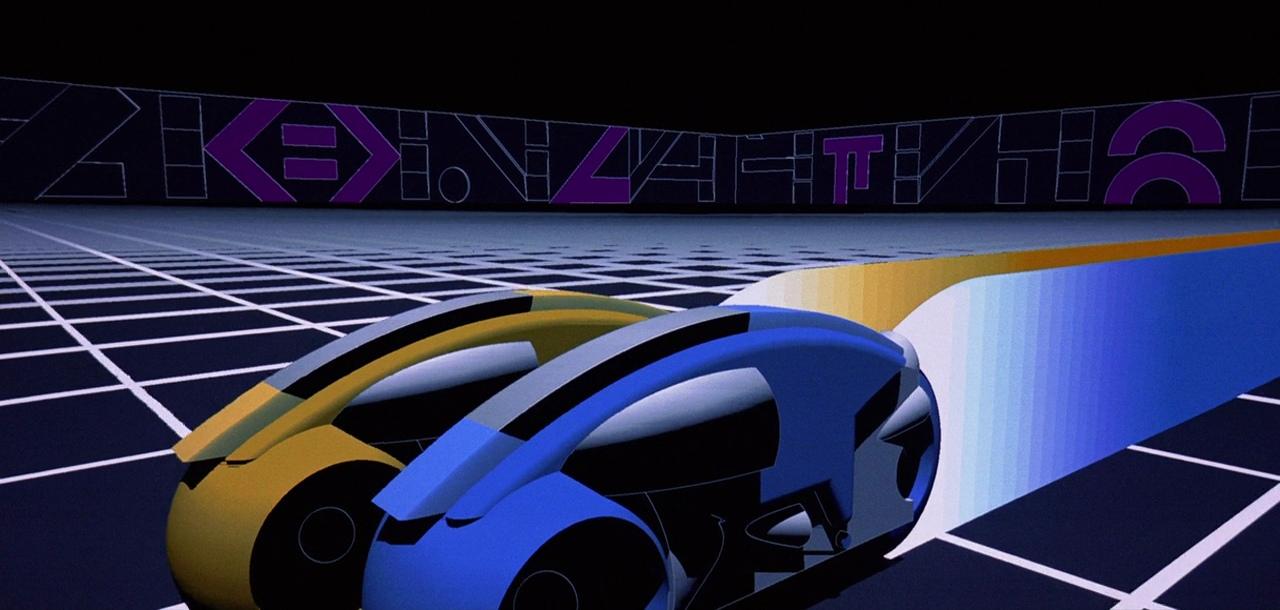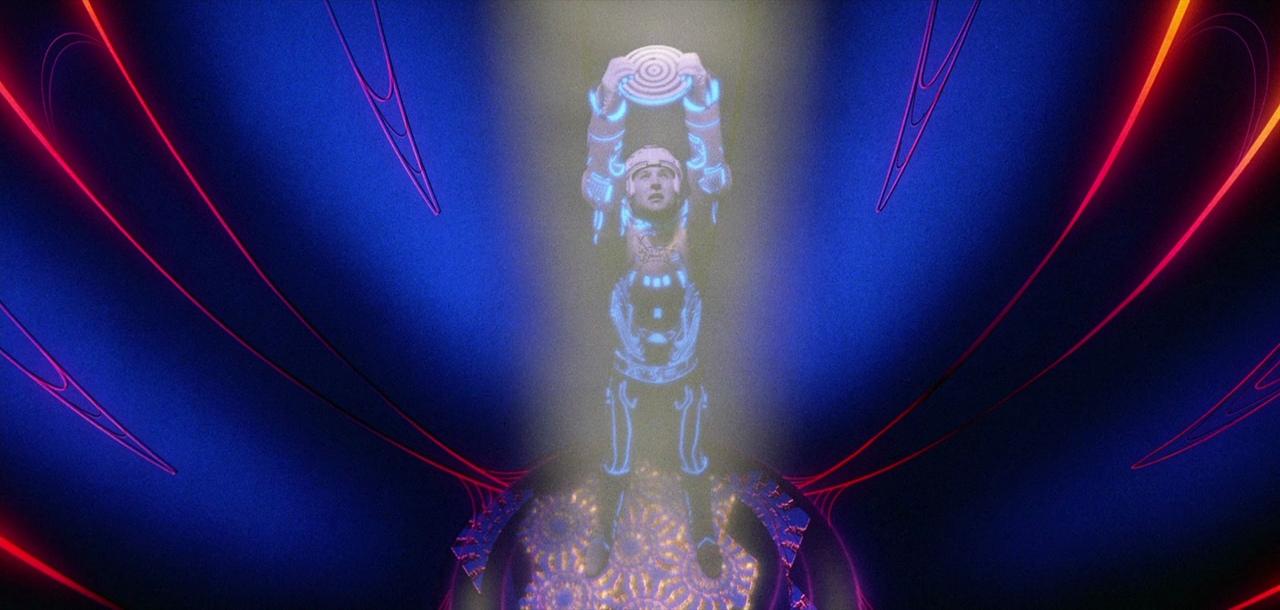When Walt Disney died in 1966, his creative vision did too. The studio that had produced the animated classics Snow White and the Seven Dwarfs, Sleeping Beauty, Dumbo, and Fantasia began focusing on live action, leading the company into genres that it had never approached before. Escape to Witch Mountain (1975), The Black Hole (1979), and The Watcher in the Woods (1980) were even rated PG (gasp!). Commercial and critical failures, they nevertheless showed that Disney was willing to take risks.
The most famous risk? Tron.
Released on July 9, 1982, and directed by Steven Lisberger, Tron starred Jeff Bridges (Kevin Flynn), Bruce Boxleitner (Alan Bradley/Tron), and Cindy Morgan (Lora Baines/Yori). It only made a reported $33 million worldwide, but it gained a cult following which lead to two sequels — Tron: Legacy (2010) and Tron: Ares (coming this fall).
And it was very prescient. In one scene an engineer says, “Computers are just machines. They can’t think,” to which Boxleitner’s Bradley replies, “Some programs will be thinking soon.”
The Beginning
Steve Lisberger (director) It started in the late ‘70s at my animation studio. We were doing a special on the Olympics, Animalympics, and that got us thinking about Olympic and gladiatorial games. Then we saw Pong and, to use a bad pun, “connected the dots.” We were working on neon logos for Animalympics. So I thought we should create a character that was neon. We called him Tron.
Bill Kroyer (co-lead animator) I was a Disney animator working on The Fox and the Hound, and Steve Lisburger talked his way onto the lot. He pitched us to come and work for him on a film called Animalympics. So I went to Lisburger studios in Venice, and Steve made me animation director. I used to have these famous artists come in on Fridays and talk to the staff, and one Friday, Walt Peregoy, one of the legendary Disney painters, came in and told us, “The golden age of animation is over.” And Steve spoke up from the back of the room: “You know something? We’re going to put things on that screen that you could never imagine.”
Lisberger Originally, we wanted to make Tron as an independent film at my studio. And then my business partner, Donald Kushner, called up Disney. We got a meeting.
Kroyer After Walt passed away, the quality of the live-action projects really nosedived, and Disney realized they needed to do something to up their game. So they hired a guy named Tom Wilhite, an up-and-coming executive they were impressed with. Wilhite greenlit Tron.
Lisberger That we had approached [Tron] like an animated project meant that we were speaking the same language as Disney. And they really liked the script. But the studio was divided. Some were very opposed to the project because they did not believe that artists should get involved with computers. But the forward-leaning faction at Disney was excited.
Kroyer The technology did not exist to make the movie that we pitched. Jumping off a cliff and building your wings on the way down, that was Tron to a tee. So we drafted those four main companies — [Digital Effects, Robert Abel & Associates, Mathematical Applications Group, Inc. (MAGi), Information International, Inc. (Triple-I)] — and together we did what I called symbiotic creativity. Jerry Reese and me storyboarded the whole movie and ended up doing all the animation. We had to interview these guys at MAGi and Triple-I and say, “What exactly can you do? What will it look like? What can be made?”
Casting Kevin Flynn
Lisberger The whole idea of Flynn as a tech shaman, I mean, he’s really archetypal. He journeys to the other dimension where he solves this problem because he has powers that most of the characters in that world don’t have.
I’ve always felt a kinship for Flynn because when we were making the film we were on Flynn’s journey. We were creating this world and trying to figure out what powers we had.
We started calling people to see what actors might be interested. When they heard that it involved video games, they thought, “It’s Disney. It’s childish. We’re not interested.” The fact that so many other people didn’t like the material because they thought it was too far out is why Jeff Bridges liked it.
Jeff Bridges (star) The walls of the soundstage were lined with video games that everyone could play for free. So we all got into these heavy competitions. My game was Battle Zone, and it was very much like Tron — all those lines and the grid and all that. And, man, they’d have to tear me off this game. I’d say, “I’m preparing for the scene!”

The Production
Lisberger What we did was break down every element of making those images into its basic component. Sometimes shots of Alan talking to Flynn weren’t even shot at the same time because we had to have everything in perfect focus. The backgrounds were CG plates that had to be composited.
Bridges It was very challenging. And then there’s acting to a blue screen…reacting to stuff that wasn’t there. I remember the sets were all black duvetyne with white adhesive tape. They basically had to be hand colored by these women in Korea. And then wearing tights and a dance belt — it makes sitting down a whole new kind of experience.
Kroyer There was no software to do animation. Computer graphics was so new that people had created software to build, texture, light, and render models. But nobody had spent time writing software to move things. So we had to render objects in 24 different positions to make one second of film. We couldn’t create motion on a computer screen that we could watch. We could only see individual frames. The first time we saw motion was when the computer companies would send us their tests.
We’re seeing our animation in 70 [mm] on these huge screens in the soundstage, and, as you might imagine, a lot of people in Disney started sneaking into those screenings. When they saw those lightcycles whipping down those corridors, they were stunned.
Lisberger I give Disney nothing but credit. Tron couldn’t have been made at any other studio. Yes, we went over budget. But we delivered on time.

The Legacy
Bridges All of that stuff has kind of come true, you know? It falls right into what’s happening with AI and all that stuff. With the second one [Tron: Legacy], I’ve literally been sucked into the computer. I got scanned and all of that, so that’s probably the end of actors making movies. Nowadays studios can say, “Give me a little bit of De Niro, some Pacino, and just throw 10% of Bridges in there.”
Lisberger Tron put Disney in a position where they were No. 1 in the world in computer animation. The film dealt with agent programs [AI programs designed to perform tasks independently, on behalf of a user or another system] decades before agent programs actually arrived. It talked about the Internet via the ARPANET [Advanced Research Projects Agency Network]. Tron touched on this idea of the world as a simulation.
I don’t think people were ready for how cutting edge it was.



